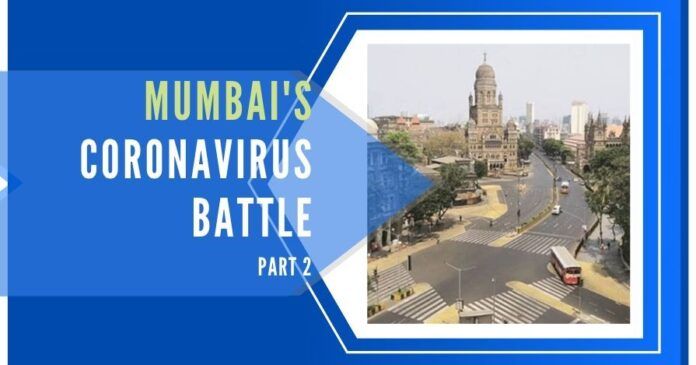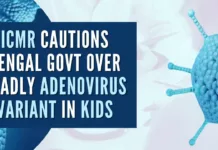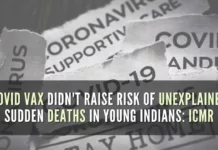
The previous part of the article can be accessed here. This is the second part.
Mumbai’s Coronavirus battle 1 crore cases Apocalyse scenario- The Data Story and Beyond
PGurus’s earlier article, which revealed the grim state of affairs in Mumbai’s sliding battle against Coronavirus epidemic[1], has set off a flurry of Whatsapp messages and phone lines have been buzzing across decision- making circles of Mumbai and Delhi. The gravity of the situation seems to have hit home and some actions have been taken by the Centre and State Government.
Even journalists, who were supporting the Shiv Sena-NCP-Congress coalition govt, are now saying that Mumbai should be handed over to the Central govt to arrest the fast deteriorating situation. NCP head honcho Sharad Pawar, who has recognized the possibility of a massive medical disaster striking the nation’s commercial capital, has now stepped out of the comfort of his SoBo bungalow and hit the streets despite his advanced age and delicate health.
On Mumbai’s worst rainy days, with thousands of rescue personnel, lakhs of stranded residents, any COVID-19 infection spread will be difficult to control and all doubling rates calculations will fail to quantify the impact.
On the lines of PGurus’ recommendation[1], Maharashtra Government-appointed COVID-19 medical task force is now looking at reserving 20,000 regular hospital beds (of the approx 30,000) exclusively for COVID cases and is contemplating invoking Disaster Management and Epidemic Acts for enabling this[2]. But, Rajesh Tope, the health minister has announced the creation of 1,00,000 isolation beds which can be in any non-hospital environment like in a stadium[3].
Mumbai’s newly-appointed Municipal Commissioner I.S. Chahal spoke about May 31st being the peak of Coronavirus surge.[4]
However, Team PGurus believes that the BMC administration and State Government are grossly incorrect to believe that May end will see the peak of Coronavirus projection, and then worst will be over. The real danger lies ahead during Mumbai’s four-month rainy season and beyond.
Four factors that may complicate efforts are outlined below.
A) Mumbai’s Monsoon – The June- Oct period sees 75% + average humidity levels in Mumbai[5], with temperatures hovering between 23-32 degrees Celsius during peak monsoon months of July till mid-September[6]. Lower temperatures and high humidity levels allow the COVID-19 virus to thrive and survive longer. As per Lancet’s study, COVID-19 virus survival ranges from 14 days at 4 degrees Celcius reducing to 1 day at 37 deg Celcius & above.
Thus Mumbai’s monsoon conditions will see the COVID-19 virus survive longer in the external environment.
B) Monsoon flooding
- As per BMC, Mumbai city features 273 flooding spots[7]. These flooding spots correspond to an immediate impact area of five million residents.
- BMC’s solid waste management, ward level maintenance departments lead flood response efforts with a field force of 10,000-15,000 personnel.
- In addition, an equal number of BMC personnel from essential services like hydraulic, garbage collection is working 24×7. They are assisted by Mumbai’s 50,000 strong police force and NDRF and SDRF forces as required, on an emergency basis.
- Many of the flooding spots, see rainwater mix with silt, debris from choked drains, and even sewage, with water stagnation for hours.
- Contact of COVID-19 infected patients with these floodwaters may enhance the danger of disease transmission, as viruses tend to adsorb onto solids in stagnant floodwater[8].
- BMC’s 15,000 strong essential service, rescue departments, and Mumbai Police who are first responders at flooding spots, are thus at risk of getting infected.
- If a lockdown is not in place during these days, the flooded streets and waters will be full lakhs of stranded residents commuting or stuck in between.
- BMC needs to redouble its efforts to ensure preventing flooding and floodwater stagnation. As of today, there is not much evidence of these efforts.
On Mumbai’s worst rainy days, with thousands of rescue personnel, lakhs of stranded residents, any COVID-19 infection spread will be difficult to control and all doubling rates calculations will fail to quantify the impact.
The medical monitoring facilities at these hospital beds, oxygen supply capacity will greatly matter and there are concerns that this capacity is highly inadequate as of today.
To compound matters, Mumbai’s current ambulance fleet may be unable to operate in flooded areas, due to their low ground clearance!
PGurus in its earlier article had precisely for this and other reasons suggested deploying a fleet of high ground clearance tractors, Indian army vehicles, and other such vehicles.[1]
C) Mumbai’s Vitamin D deficiency population– Many studies are reporting a link between low Vitamin –D levels, lower immunity levels, and high COVID-19 patients mortality rates[9][10][11]. Depending on the measure of reference, between 40-70% of Mumbai’s population is classified as Vitamin-D deficient[12][13].
D) Mumbai’s TB patients – PGurus in the earlier article highlighted troubles faced by non-COVID patients a view echoed by the High Court as well[14][15]. Tuberculosis or TB is one of India’s biggest killers and also a highly infectious disease. Mumbai city hosts 60,000 odd TB patients, per National TB report[16]. They are high-risk patients for COVID-19 infection spread. It is most concerning that Mumbai’s Coronavirus hotspots, coincide with Mumbai’s TB hotspots. A recent article highlighted the troubles of these TB patients in continuing their medication[17].
In view of the above factors, Team PGurus would like to reiterate its suggestion for the requirement of 250,000 beds, based on the following considerations.
- All high-risk contacts from Coronavirus hotspots and across the city staying in slums, chawls will need to be shifted and put up in isolated facilities for the period of the monsoon season.
- About 70-80% of the 60,000 TB patients in Mumbai may need to be moved to BMC’s quarantine, isolation, and treatment facilities during monsoon. Keeping them in-situ may increase COVID-19 infection risk.
- BMC’s new policy calls for contract tracing in the ratio of 1:10. With Mumbai currently throwing up about 1000 new cases/day, there would need to evaluate quarantine for 8,000-10,000 people per day.
- More than 100,000 beds may be needed for monitoring existing Coronavirus high-risk cases and TB patients.
Of course, the medical monitoring facilities at these hospital beds, oxygen supply capacity will greatly matter and there are concerns that this capacity is highly inadequate as of today.[18]
The combined impact of Mumbai’s monsoons, weather, flooding, Vitamin-D deficient population, and a high number of non-quarantined high risk as well as TB patients, will create a perfect storm in multiplying the Coronavirus disease count and spread.
Team PGurus in the public interest, would like to pose a series of questions for BMC and State Governments to answer
- What is the current assessment of BMC in terms of Coronavirus cases projections?
- Have the BMC and the State Government quantified the impact of the above monsoon factors in terms of Coronavirus cases?
- What is BMC’s progress in its critical pre-monsoon work? Why not approach Indian Railways for help to augment its labor shortage?[19]
- What will be the BMC’s lockdown policy for monsoons and such rainy days?
- What will be BMC’s official operating procedure for dealing with flooding in Coronavirus hotspots?
- Has BMC made plans to equip its flood relief staff and the rescue teams with safety measures? What are those measures?
- Why is BMC shy of releasing detailed COVID-19 data? New York city’s COVID-19 page gives a detailed breakdown by date, area, age, and gender[20].
- Despite the help of top data analytics, statistics companies like Fractal, Mckinsey, and BCG, why is BMC unable to present to report municipal ward wise data?
- Wouldn’t the transparent release of the above data including by religion help to communicate the message about the seriousness of this crisis to the right communities?
- Why is BMC and State Government not pursuing ICMR for deploying 1-hour COVID-19 confirmatory test kits and such technologies as mentioned earlier?
Team PGurus believes the transparent reporting of COVID-19 data and mortality rates will lead to greater awareness of the danger at hand and lead to meaningful collective individual actions across all communities and religions. The current data vagueness is furthering suspicion of pandering to vested interests in name of secularism with counterproductive results.
References:
[1] Mumbai’s Coronavirus battle – Apocalypse now? – May 10, 2020, PGurus.com
[2] Mumbai’s last stand as city nears its peak – May 15, 2020, Mumbai Mirror
[3] Mumbai to set up 1 lakh beds for Covid-19 patients, reserve 60% in pvt hospitals – 15 May 2020, Livemint
[4] Mumbai may have 45,000 to 46,000 cases by May-end, projects BMC chief – May 14, 2020, Hindustantimes
[5] Average Humidity In Mumbai (Maharashtra) – Weather and Climate
[6] Average Weather in Mumbai – Weatherspark
[7] Mumbai monsoon audit:A spot check of chronic flooding areas – Jun 03, 2019, Hindustantimes
[8] Survival of Coronaviruses in Water and Wastewater – Dec 3, 2008, Nih.gov
[9] Vitamin D levels appear to play role in COVID-19 mortality rates – May 7, 2020, Science Daily
[10] The role of vitamin D in the prevention of coronavirus disease 2019 infection and mortality
– May 06, 2020, Springer
[11] Explained: What data from 20 countries show on Covid-19’s Vitamin D link – May 12, 2020, Indianexpress
[12] 70-90% of Indians are Vitamin D deficient: Study – Aug 28, 2019, Indiatimes
[13] Vitamin D levels rising among Mumbaikars – Jun 4, 2018, Times of India
[14] Coronavirus | Non-COVID-19 patients find care out of reach at Mumbai hospitals – Apr 25, 2020, The Hindu
[15] Treatment of non-covid patients: Explore every option to minimise suffering at large, says Bombay HC – May 17, 2020, Indianexpress
[16] India Tb Report – TBC India
[17] TB patients badly hit by lockdown — 80% drop in diagnosis, huge struggle for medicines – 30 April, 2020, The Print
[18] Mumbai gasps as grand hospital plans remain on paper – May 16, 2020, Times of India
[19] Pandemic derails pre-monsoon work: BMC stares at yet another challenge – May 15, 2020, Indianexpress
[20] COVID-19: Data NYC – May 18, 2020, NYC Health
- Defence Minister Rajnath Singh visits Siachen. Reviews military preparedness - April 22, 2024
- Amit Shah’s shares in the Stock Market almost doubled in the past five years - April 21, 2024
- ED accused Rahul wants ED to arrest Kerala Chief Minister, while objecting to the arrests of Delhi and Jharkhand chief ministers - April 21, 2024











[…] Coronavirus battle- Part 2 PGurus #MeraMumbai #Mumbai #News Read More » Share 0 Tweet Share Share […]